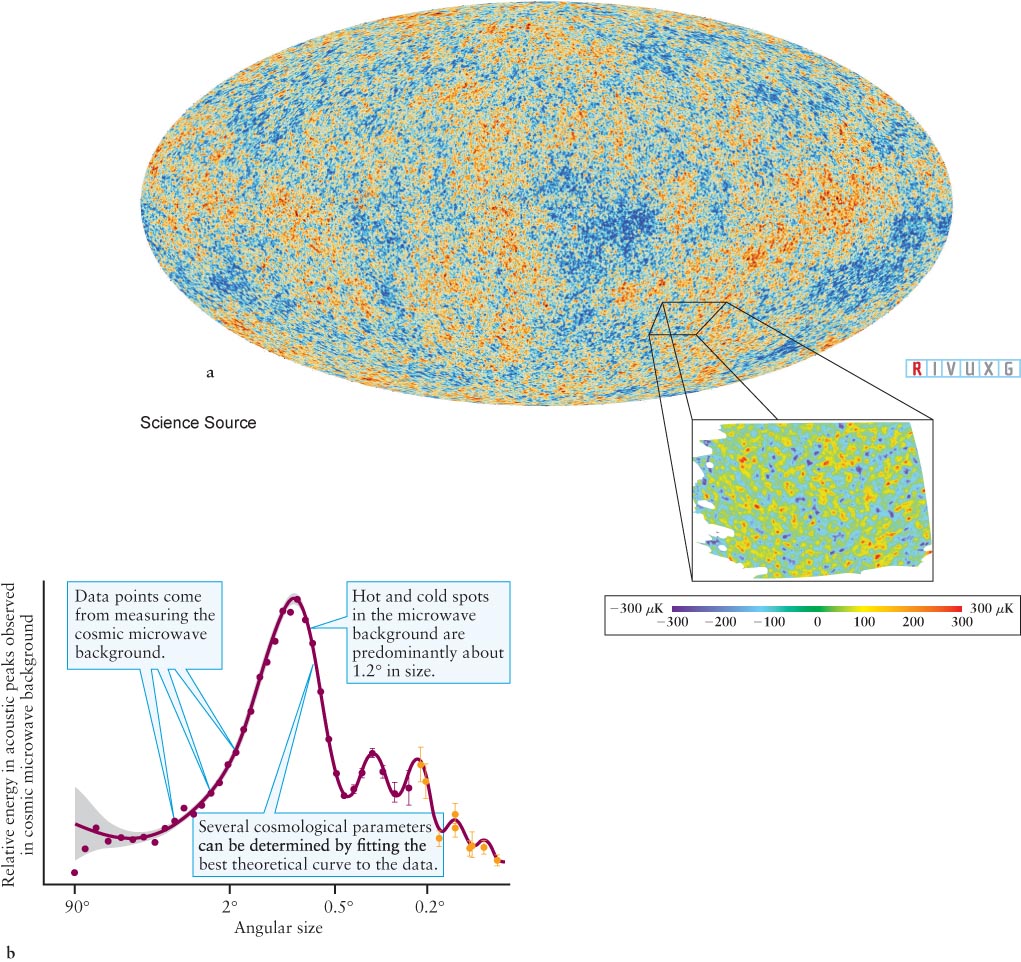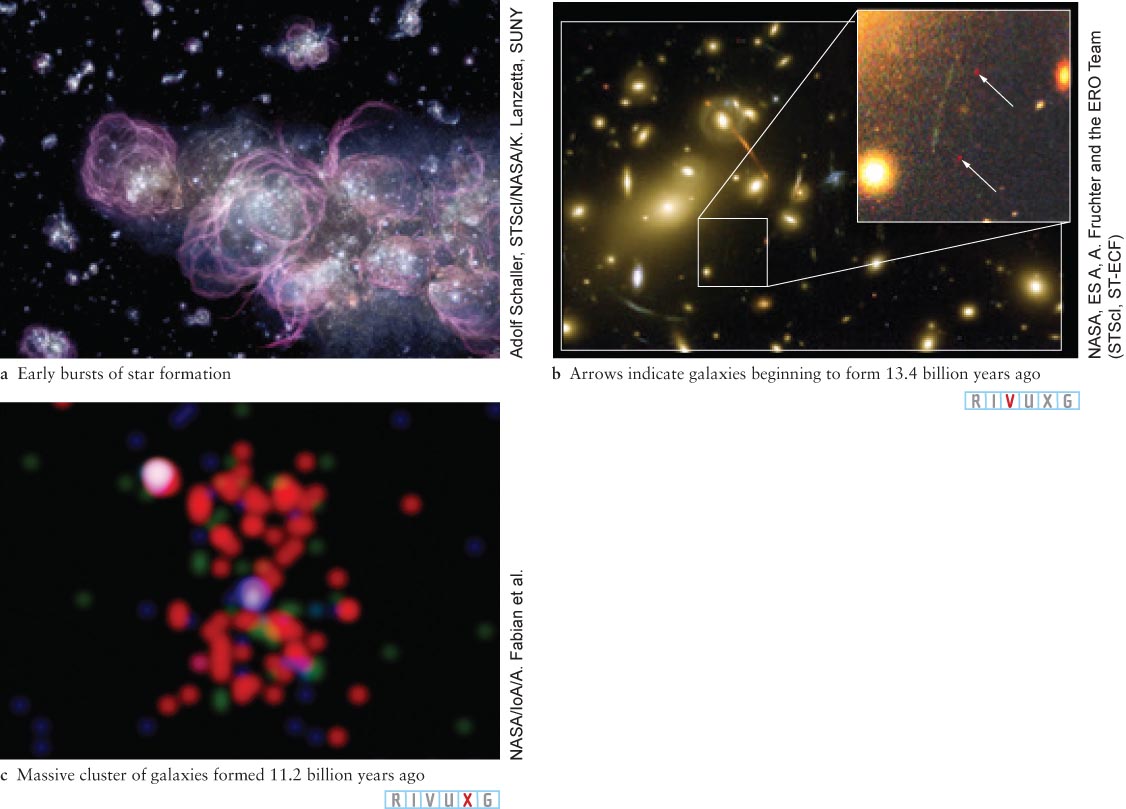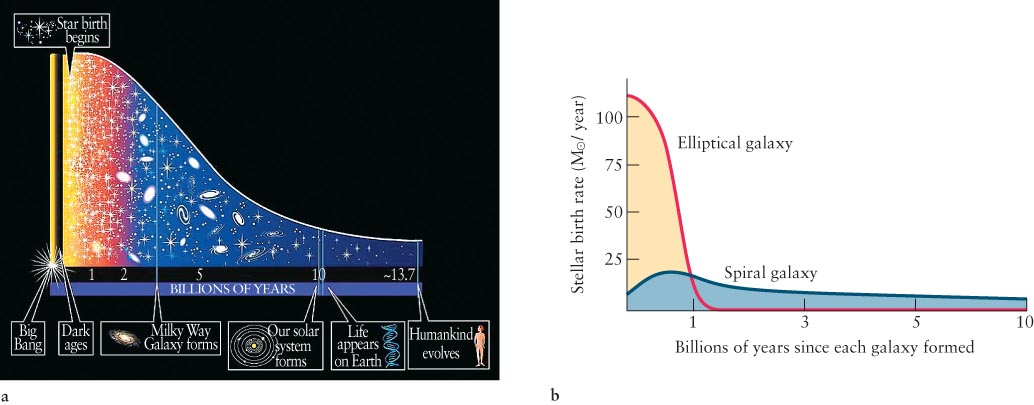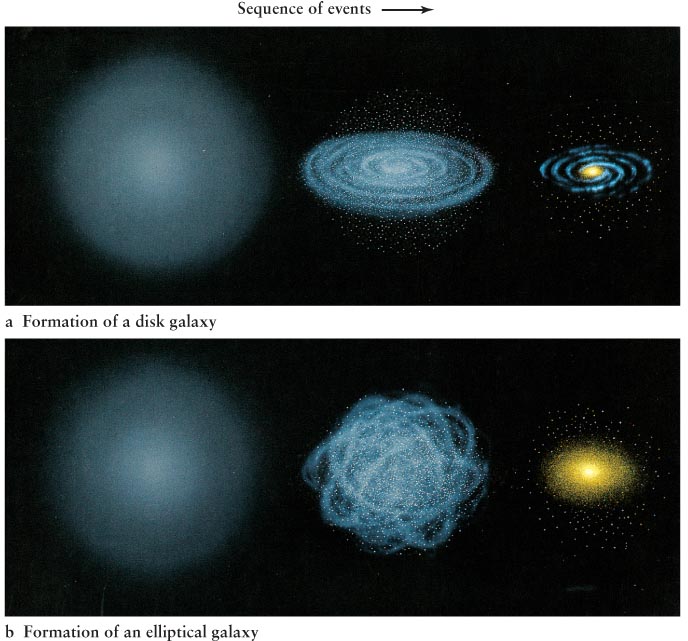THE STRUCTURE OF THE UNIVERSE
The Big Bang theory explains the evolution of space-
14-11 Galaxies formed from huge clouds of primordial gas
Had the universe been perfectly uniform until the era of recombination (that is, everywhere perfectly homogeneous and isotropic), it would have been impossible for stars, galaxies, and larger groupings of matter to form, pulled together as they were by differences in mass density and, hence, gravitational attraction. Quantum theory is believed to have played a vital role during the inflationary epoch in creating the clumpiness that we observe today as superclusters of galaxies. In 1927, the British physicist Paul A. M. Dirac concluded that the laws of nature allow pairs of particles to spontaneously appear, provided that they are identical to each other except for having opposite electric charges, and that they annihilate each other and disappear within a very short period of time, typically 10-21 seconds. As discussed in Section 12-
456
Normally, quantum fluctuations (the spontaneous formation of pairs of virtual particles) occur on the size scales of pairs of particles. However, the quantum fluctuations on microscopic scales that were occurring during the inflationary period were stretched by the inflation until they were large enough to affect the spacetime around them. Those particles created tiny regions of slightly higher temperature, density, and pressure in the inflating universe, like little firecrackers going off all over the place. Also like firecrackers, those events sent out sound waves that traveled through the rapidly expanding universe. These sound waves are believed to have led to the formation of superclusters of galaxies. Here is how that may have taken place.
Whereas light waves, like ocean waves, change amplitude perpendicular to the direction they travel, sound waves change the density of the material through which they move in the direction of their motion. In other words, sound waves are waves that compress and rarefy (make thinner) the medium through which they travel. The rate at which these compressions and rarefactions in the air enter your ears each second, for example, determines the pitches of the sounds you hear. As quantum fluctuations stretched out in the early universe, they compressed the surrounding medium, sending out spherical sound waves, which traveled as long as the gas in the young universe could support them. The speed of these sound waves was impressive by everyday standards. Sound in our atmosphere travels at about 350 m/s (1100 ft/s). The sound waves generated in the inflating universe traveled at 1.75 × 105 m/s (5.75 × 105 ft/s).
The sound waves created at the end of inflation in the early universe traveled out through the plasma of the universe until decoupling, 380,000 years later. At that time, when photons no longer scattered quickly off the gas in the universe, the waves stopped moving.
Because those sound waves were compression and rarefactions of the gas in the young universe, when they stopped traveling, they established shells of higher-

 Structure of the Early Universe (a) This microwave map of the entire sky, produced from data taken by the Planck Space Telescope, shows temperature variations in the cosmic microwave background. Red regions are about 0.00003 K warmer than the average temperature of 2.73 K; blue regions are about 0.00003 K cooler than the average. These tiny temperature fluctuations are related to the large-
Structure of the Early Universe (a) This microwave map of the entire sky, produced from data taken by the Planck Space Telescope, shows temperature variations in the cosmic microwave background. Red regions are about 0.00003 K warmer than the average temperature of 2.73 K; blue regions are about 0.00003 K cooler than the average. These tiny temperature fluctuations are related to the large-Astrophysicists have plotted the angular sizes of the peaks (warm regions) created by the acoustic (sound) waves, as shown in Figure 14-
We can now outline the scenario for how matter clumped in the early universe. When the universe was radiation-
The voids seen throughout the cosmos (see Section 13-
The first generation of stars is called Population III stars. Except for a trace of lithium, they were completely devoid of metals. Computer simulations indicate that many of these stars had masses in the range 100–
457
If, as is now believed, some of the earliest stars had masses in the range of stars found in our Galaxy, it is possible that the low-
458
By observing remote galaxies, astronomers have discovered that most galaxies initially emitted energy we associate with quasars and other active galaxies. This implies that most galaxies have supermassive black holes at their centers. The earliest quasars dating back to when the universe was only 900 million years old provide information about when the first stars formed. Those quasars have spectral lines created by iron and magnesium. In order for those elements to be in those quasars, the iron and magnesium had to be created in stars that formed 700 million years earlier (then exploded and put the metals into the interstellar medium). These metals were then attracted by the black hole. This scenario means that the first stars existed within 200 million years of the Big Bang (Figure 14-


 Galaxies Forming by Combining Smaller Units (a) This image indicates how astronomers visualize the burst of star formation that occurred within a few hundred million years after the Big Bang. The arcs and irregular circles represent interstellar gas illuminated by supernovae. (b) Using the Hubble and Keck telescopes, astronomers discovered two groups of stars (arrows) 13.4 billion light-
Galaxies Forming by Combining Smaller Units (a) This image indicates how astronomers visualize the burst of star formation that occurred within a few hundred million years after the Big Bang. The arcs and irregular circles represent interstellar gas illuminated by supernovae. (b) Using the Hubble and Keck telescopes, astronomers discovered two groups of stars (arrows) 13.4 billion light-By 500 million years after the Big Bang, galaxies were beginning to coalesce (Figure 14-
From about 600 million years to about 2.6 billion years after it formed, the universe underwent heavy star formation. Galaxies grew in size during this period, some continuously, others suddenly and quickly. Star formation decreased as the amount of interstellar hydrogen diminished. One observed galaxy, with about 8 times the mass in stars as the Milky Way has, reached its full star-
Observations also reveal that galaxies were bluer and brighter in the past than they are today. These changes in color and brightness suggest a high abundance of young, bright, hot, massive stars in newly formed galaxies (Figure 14-

459
In contrast, spiral galaxies have been forming stars for at least the past 10 billion years, although at a gradually decreasing rate. There is still plenty of interstellar hydrogen in the disks of spiral galaxies, like our Milky Way, to fuel star formation today. That is why O and B stars still highlight their spiral arms. Figure 14-
14-12 Star formation activity determines a galaxy’s initial structure
Imagine a developing galaxy, called a protogalaxy, forming from a cloud of gas. Theory proposes that the rate of star formation determines whether this protogalaxy becomes a spiral or an elliptical galaxy. If stars form slowly enough, then the gas surrounding them has plenty of time to settle by collision with other infalling gas into a flattened disk, just like the early solar system. Star formation continues because the protogalactic disk contains an ample supply of hydrogen, and a spiral or lenticular (disk-

460
Focus Question 14-10
If the first elements were hydrogen, helium, and lithium, where did Population II stars in globular clusters and elsewhere get their other metals?
One intriguing nearby galaxy, NGC 1277, apparently didn’t play by the normal rules of galactic evolution. It is a lenticular galaxy: It has a disk, but no spiral arms, with a 17 billion M⊙ supermassive black hole in its nucleus. Observations suggest that it formed very rapidly (over a 100 million year period) early in the life of the universe and has not changed since then. Normally, such massive black holes take much longer to form. Other lenticular galaxies evolve due to gravitational interactions with neighboring galaxies, but not NGC 1277. Understanding both the stable lenticular structure and the rapidly formed, extremely massive central black hole are works in progress.
Focus Question 14-11
If dark matter did not exist, would any gravitational lensing occur in the universe?

Not all galaxies maintain their initial structure over the evolution of the universe. As we discussed in Section 13-
Determining the location and nature of the dark matter in the universe (see Chapter 13) is still of paramount importance in understanding the cosmos. The observable stars, gas, and dust in a galaxy or cluster of galaxies account for only about 10% to 20% of each object’s mass. (Recall that this observable matter does not have enough mass to hold galaxies or clusters of galaxies together.) We have very little idea of what the composition of the remaining 80% to 90% of each galaxy or cluster of galaxies is. However, some progress in understanding the distribution of this dark matter is being made. In 2002, astronomers who map large numbers of galaxies and use computer simulations of the effects of dark matter determined that on the scales of clusters of galaxies, the locations of the galaxies often coincide with the concentrations of dark matter, while voids between clusters coincide with voids of dark matter. It is likely that the gravitational force of the dark matter caused gas to concentrate in the same regions, thereby stimulating formation of supermassive black holes and galaxies. In 2007, using images of galaxies that were focused by a gravitational lens of dark matter, astronomers were able to plot the locations of this dark matter (Figure 14-